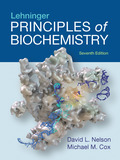
Concept explainers
To determine: The positions in the purine ring of a purine
Introduction:
There are two types of nitrogenous bases: purines and pyrimidines. Adenine and guanine are the purine bases with double ring structures. Cytosine and thymine are the pyrimidines bases that have single ring structure. These bases pair with their complementary bases and form a nucleotide sequence through hydrogen bonding.
Explanation of Solution
Explanation:
Adenine is linked to thymine with double hydrogen bond and guanine is linked to cytosine with triple hydrogen bond. The two nucleotides are joined together by the phosphodiester bond.
Purine is a structure that contains nine member ring which is made up of a imidazole ring along with a pyrimidine ring. In adenine amino group present at the sixth position along with first position’s nitrogen is involved in Watson-Crick base pairing with complementary pyrimidine base which is thymine.
In guanine, nitrogen present at first position and amino group at second carbon along with oxo group at sixth carbon is involved in Watson-Crick base pairing with complementary pyrimidine base which is cytosine.
Thus, the positions of purine ring that have the property to form hydrogen bonds but do not participate in Watson-Crick base pairing are the nitrogen which is present at third and seventh position of purine ring.
Conclusion:
Third and seventh positions in purine ring are involved in hydrogen bonding but do not involve in Watson-Crick base pairing.
Want to see more full solutions like this?
Chapter 8 Solutions
EBK LEHNINGER PRINCIPLES OF BIOCHEMISTR
- What is the formation of glycosylated hemoglobin (the basis for the HbA1c test)? Can you describe it?arrow_forwardPlease analze the gel electrophoresis column of the VRK1 kinase (MW: 39.71 kDa). Also use a ruler to measure the length of the column in centimeters and calculate the MW of each band observed. Lane 1: buffer Lane 2 : Ladder Lane 3: Lysate Lane 4: Flowthrough Lane 5: Wash Lanes 6-8: E1, E2, E3 Lane 9: Dialyzed VRK1 Lane 10: LDHarrow_forwardDo sensory neurons express ACE2 or only neurolipin-1 receptors for COVID19 virus particle binding?arrow_forward
- Explain the process of CNS infiltration of COVID19 through sensory neurons from beginning to end, including processes like endocytosis, the different receptors/proteins that are involved, how they are transported and released, etc.,arrow_forwardH2C CH2 HC-COOO CH2 ܘHO-C-13c-O isocitrate C-S-COA H213c CH2 C-OO 13C-S-COA CH2 C-00 the label will not be present in succinyl CoA C-S-COA succinyl-CoAarrow_forwardA culture of kidneys cells contains all intermediates of the citric acid cycle. It is treated with an irreversible inhibitor of malate dehydrogenase, and then infused withglucose. Fill in the following list to account for the number of energy molecules that are formed from that one molecule of glucose in this situation. (NTP = nucleotidetriphosphate, e.g., ATP or GTP)Net number of NTP:Net number of NADH:Net number of FADH2:arrow_forward
- 16. Which one of the compounds below is the final product of the reaction sequence shown here? OH A B NaOH Zn/Hg aldol condensation heat aq. HCI acetone C 0 D Earrow_forward2. Which one of the following alkenes undergoes the least exothermic hydrogenation upon treatment with H₂/Pd? A B C D Earrow_forward6. What is the IUPAC name of the following compound? A) (Z)-3,5,6-trimethyl-3,5-heptadiene B) (E)-2,3,5-trimethyl-1,4-heptadiene C) (E)-5-ethyl-2,3-dimethyl-1,5-hexadiene D) (Z)-5-ethyl-2,3-dimethyl-1,5-hexadiene E) (Z)-2,3,5-trimethyl-1,4-heptadienearrow_forward
- Consider the reaction shown. CH2OH Ex. CH2 -OH CH2- Dihydroxyacetone phosphate glyceraldehyde 3-phosphate The standard free-energy change (AG) for this reaction is 7.53 kJ mol-¹. Calculate the free-energy change (AG) for this reaction at 298 K when [dihydroxyacetone phosphate] = 0.100 M and [glyceraldehyde 3-phosphate] = 0.00300 M. AG= kJ mol-1arrow_forwardIf the pH of gastric juice is 1.6, what is the amount of energy (AG) required for the transport of hydrogen ions from a cell (internal pH of 7.4) into the stomach lumen? Assume that the membrane potential across this membrane is -70.0 mV and the temperature is 37 °C. AG= kJ mol-1arrow_forwardConsider the fatty acid structure shown. Which of the designations are accurate for this fatty acid? 17:2 (48.11) 18:2(A9.12) cis, cis-A8, A¹¹-octadecadienoate w-6 fatty acid 18:2(A6,9)arrow_forward
 BiochemistryBiochemistryISBN:9781319114671Author:Lubert Stryer, Jeremy M. Berg, John L. Tymoczko, Gregory J. Gatto Jr.Publisher:W. H. Freeman
BiochemistryBiochemistryISBN:9781319114671Author:Lubert Stryer, Jeremy M. Berg, John L. Tymoczko, Gregory J. Gatto Jr.Publisher:W. H. Freeman Lehninger Principles of BiochemistryBiochemistryISBN:9781464126116Author:David L. Nelson, Michael M. CoxPublisher:W. H. Freeman
Lehninger Principles of BiochemistryBiochemistryISBN:9781464126116Author:David L. Nelson, Michael M. CoxPublisher:W. H. Freeman Fundamentals of Biochemistry: Life at the Molecul...BiochemistryISBN:9781118918401Author:Donald Voet, Judith G. Voet, Charlotte W. PrattPublisher:WILEY
Fundamentals of Biochemistry: Life at the Molecul...BiochemistryISBN:9781118918401Author:Donald Voet, Judith G. Voet, Charlotte W. PrattPublisher:WILEY BiochemistryBiochemistryISBN:9781305961135Author:Mary K. Campbell, Shawn O. Farrell, Owen M. McDougalPublisher:Cengage Learning
BiochemistryBiochemistryISBN:9781305961135Author:Mary K. Campbell, Shawn O. Farrell, Owen M. McDougalPublisher:Cengage Learning BiochemistryBiochemistryISBN:9781305577206Author:Reginald H. Garrett, Charles M. GrishamPublisher:Cengage Learning
BiochemistryBiochemistryISBN:9781305577206Author:Reginald H. Garrett, Charles M. GrishamPublisher:Cengage Learning Fundamentals of General, Organic, and Biological ...BiochemistryISBN:9780134015187Author:John E. McMurry, David S. Ballantine, Carl A. Hoeger, Virginia E. PetersonPublisher:PEARSON
Fundamentals of General, Organic, and Biological ...BiochemistryISBN:9780134015187Author:John E. McMurry, David S. Ballantine, Carl A. Hoeger, Virginia E. PetersonPublisher:PEARSON





